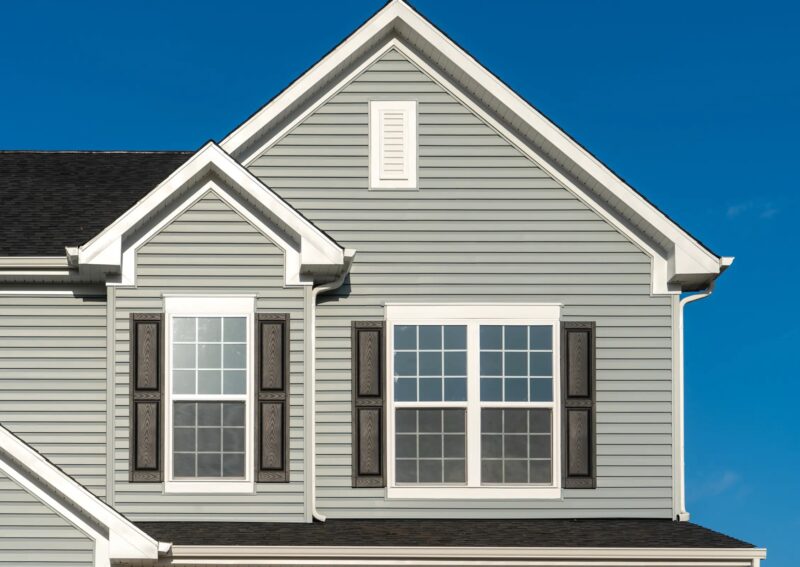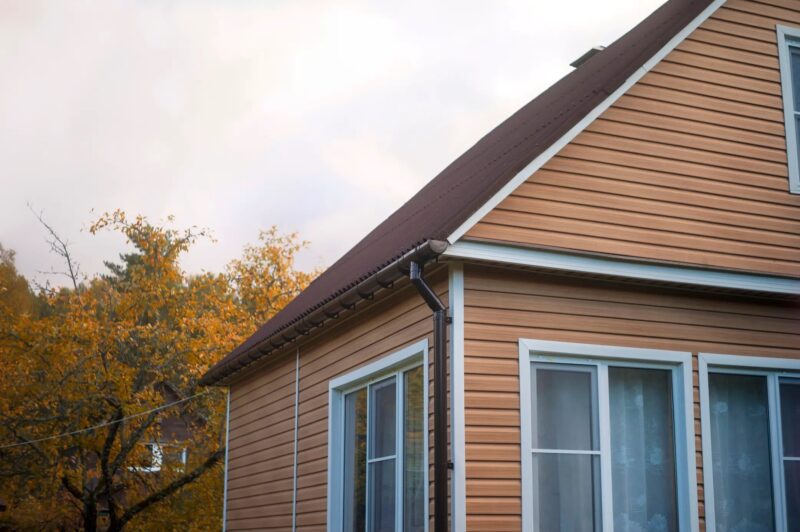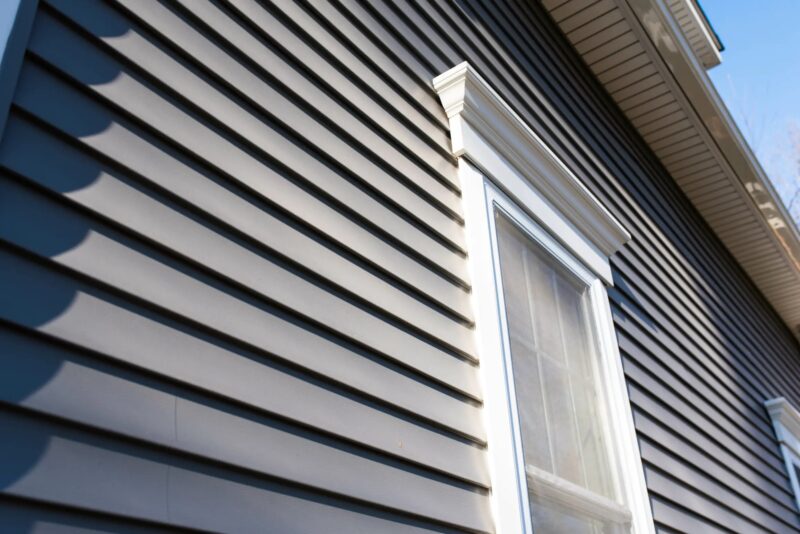
When it comes to exterior siding for your home, vinyl siding is a top choice. It’s durable, long-lasting, and comes in various colors and styles. Best of all, it never needs to be painted. The average vinyl siding cost in the U.S.A. is $11,000, ranging from $6,000 to $16,400, or about $4 to $14 per square foot. We’re going over all of the costs associated with vinyl siding, including installation, money-saving tips, and answers to common questions.
When You Should Get Vinyl Siding
The aesthetics of vinyl siding have improved in the past several years as the technology used to manufacture it has advanced. While vinyl siding was once criticized for its plastic-like appearance, new vinyl siding is attractive, mimicking traditional materials like wood, cedar shakes, and brick.
Signs Your Home Needs New Siding
Depending on the quality, vinyl siding lasts 20 to 40 years. While you may be able to make repairs to increase its lifespan, several signs indicate that it’s time for replacement.
Visible Damage
Blistering, bubbling, warping, sagging, and cracking are all common signs of visible damage on vinyl siding. Damage can be caused by sunlight, heat exposure, poor installation, or human error. Extensive damage may require replacement.
Fading or Discoloration
While vinyl siding is manufactured to be UV-resistant, it will fade over time. The parts of your home that have more sun exposure will fade faster, resulting in uneven coloring that reduces your home’s curb appeal.
Moisture Issues
Vinyl siding doesn’t absorb moisture, but if it’s damaged or installed incorrectly, moisture can get between the exterior wall and the vinyl siding. Once moisture gets in, it can deteriorate the wood underneath your siding.
High Maintenance
One of the best things about vinyl siding is that it is low-maintenance. However, as vinyl siding ages, it may start cracking, sagging, and buckling, requiring more maintenance.
Energy Efficiency Concerns
Insulated vinyl siding is one of the best types of siding for keeping your home cool in the summer and warm in the winter. However, if your vinyl siding isn’t insulated, it won’t add that extra layer of protection, so you may want to replace it if you’re looking for a more energy-efficient siding.
Importance of Timing for Siding Replacement
Vinyl is sensitive to temperature extremes. Heat causes vinyl siding to stretch, and cold weather causes it to shrink, which is why replacing it during the winter or summertime can lead to issues with gaps or buckling. The best time to replace it is in the fall when the temperatures are cool and even.
Preventing Further Damage
While repairing your vinyl siding is often more cost-effective than replacing it, installing new vinyl siding can help you avoid further damage to your home.
When damaged siding isn’t repaired in a timely manner, there may be hidden damage to your home’s exterior. You won’t be able to address it unless you completely replace the siding.
Curb Appeal and Property Value
Improvements to the exterior of your home directly enhance your home’s curb appeal and can increase your property value. The return on investment for vinyl siding is only about 60% to 80%. However, if you’re selling your home, it can mean the difference between a sale or having it sit on the market for months.
Seasonal Considerations
Heading into winter with damaged siding can result in additional damage to the structural integrity of your home, especially because you may not be able to get it repaired for several months. While you wait, moisture and freeze-thaw cycles will worsen the damage to your home’s exterior.
The Benefits of Vinyl Siding

Vinyl siding is economical, saving homeowners money on maintenance and repair costs. Take a look at the benefits it offers to see if vinyl siding is right for you.
Durability and Low Maintenance
Besides price, durability is the number one reason people choose vinyl siding. Its low-maintenance features also add to its appeal. Unlike other types of siding, vinyl is resistant to rot, decay, and insect damage, and it doesn’t need to be painted, saving you money every few years.
All it takes to keep vinyl siding looking its best is cleaning with mild detergent and water. Inspect it at least annually, and you’ll enjoy many years of long-lasting appeal.
Energy Efficiency
Insulated vinyl siding enhances your home’s energy efficiency, reducing heating and cooling costs. The additional thermal barrier also helps regulate indoor temperatures more effectively, making your home more comfortable.
Aesthetic Appeal
A wide range of styles, textures, and colors of vinyl siding are available, allowing homeowners to find a personalized look that improves the curb appeal of their home. Vinyl siding comes in various widths and colors, so you aren’t limited to just a few choices.
Factors in Calculating Costs of Vinyl Siding

Several factors must be considered when calculating vinyl siding costs. The most significant factors are the project’s size and scope, material prices, and the labor cost of siding a house with vinyl.
Size and Scope of the Project
The size and scope of your project are the most significant factors determining the vinyl siding cost. Large homes not only have more square footage, but they also have more doors, windows, and architectural features that increase costs.
Material Quality and Grades
High-quality siding costs more. However, when deciding what grade of siding to use, you should factor in the replacement cost, including installation labor costs.
Labor Costs and Location
Labor costs are a significant factor in the cost of vinyl siding. The cost of labor is influenced by regional labor markets, the complexity of the job, and the skill level of your installer. If you’re an experienced DIYer, you can install it yourself and potentially save thousands of dollars.
Additional Vinyl Siding Costs and Considerations

Here are some additional costs and considerations associated with pricing for vinyl siding.
Insulation
If you need to add insulation to your home before installing siding, it will cost more. You may also choose insulated vinyl siding, which costs about 50% to 100% more than hollow siding.
Weather Barriers
House wrap is a weather barrier that protects the sheathing of your home and prevents air circulation. It’s well worth the additional cost, which averages about $0.70 to $1.00 per square foot.
Trim and Accessories
Homes with more doors, windows, and architectural features require more trim and accessories, which adds to the cost.
Disposal Fees and Environmental Considerations
Old siding must be properly disposed of, and while it may be included in your quote, it could cost extra. Since vinyl siding is recyclable, start by looking for building material recycling centers in your area.
Vinyl Sidings by Type
Explore vinyl siding types and prices by comparing features, styles, and colors.
Overview of Vinyl Siding Types
You have a lot of choices when it comes to vinyl siding.
Here are the most common types:
- Clapboard
- Traditional lap
- Dutch lap
- Wood grain
- Beaded seam
- Board-and-batten
- Cedar shake
- Half-round scalloped
- Log
Comparing Costs and Features
Vinyl siding comes in various widths and thicknesses. While the thickness of the material affects the cost of replacing vinyl siding on your house, the width doesn’t usually have an impact.
- Must be at least 0.035 inches thick.
- Anything above 0.048 is considered premium siding.
- Common widths are 4, 5, 6, and 7 inches.
Popular Styles and Colors
There are many different colors and styles of vinyl siding to choose from.
- Neutral tones-white, beige, and gray
- Earth tones– tan, brown, and green
- Bold tones– blue, red, and green
Whether you’re opting for bold colors or earth tones, the color you choose affects everything from your home’s resale value to how much your siding is impacted by solar heat.

Breaking Down the Costs
Vinyl siding installation labor costs $1 to $6 per square foot, and materials cost $3 to $8. Costs vary depending on the square footage of exterior walls, the number of doors and windows in your home, the quality of materials, and other factors, like gables.
For most homes, you can use the square feet of floor space to calculate the cost of siding, which will be accurate within about 200 square feet. This method is accurate for large homes within approximately 500 square feet.
| Square feet of siding | Cost for materials | Cost including installation |
| 1,000 | $2,000 to $10,000 | $4,000 to $15,000 |
| 2,000 | $4,000 to $20,000 | $8,000 to $30,000 |
| 3,000 | $6,000 to $30,000 | $12,000 to $45,000 |
| 5,000 | $10,000 to $50,000 | $20,000 to $75,000 |
Hidden Costs
The estimated cost for vinyl siding on a house may not consider the following hidden expenses:
- Permit and inspection fees
- Site preparation costs
- Cleanup and disposal costs
- Cost to repair damaged sheathing and studs
- Additional warranty costs
DIY Vinyl Siding Installation vs. Hiring a Professional

Vinyl siding installation is an appropriate project for DIYers with the right skills, but it may be beyond the scope of many people’s level of expertise.
Pros and Cons of DIY Installation
The primary benefit of DIY installation is the cost savings, but installing your own siding can also elevate your sense of pride in your home and feelings of accomplishment.
On the downside, mistakes can require additional material costs, put your home at risk of damage, and lower the potential resale value of your home.
Benefits of Hiring a Professional
Expert installations are flawless and efficient. Professionals can install exterior siding on your home in 4 to 14 days, depending on the size of your home. Some vinyl siding manufacturers offer a warranty on their product contingent on having it professionally installed, and many homeowners prefer to hire a professional for the peace of mind it gives them.
How to Save Money on Vinyl Siding

Follow these money-saving tips to lower your vinyl siding costs.
Negotiating with Contractors
Obtain at least three quotes for installation so you can negotiate with contractors. Ask them if you can get a discount for doing some of the work yourself, such as removing old siding.
Seeking Discounts and Financing Options
Most contractors offer various discounts, such as seniors’ or veterans’ discounts. You can also look for companies that offer a first-time customer discount. Seasonal discounts are another option, but remember that it’s best to avoid installing it during extreme temperatures.
To finance your siding costs, talk to your bank about refinancing your home or taking out a home equity loan line of credit.
5 FAQs About the Costs of Vinyl Siding
What Is the Average Price of Vinyl Siding?
Vinyl siding installation costs about $4 to $14 per square foot, including labor and materials. To calculate siding costs for your home, you can use the square footage of your home and multiply that number by the cost per square foot.
Are There Any Additional Maintenance Costs?
Vinyl siding is easy to care for, only requiring regular cleaning with mild detergent. However, if your siding is damaged, it could cost $50 to $100 to repair small holes. Depending on the type and extent of damage, the cost to repair vinyl siding is between $2 and $50 per square foot.
Is DIY Siding Installation Cost-Effective?
Experienced DIYers can save money on installations, but it may take longer. Recognizing the risks of DIY installation is essential because mistakes can be expensive.
Can I Replace Vinyl Siding Over Existing Siding?
Most manufacturers don’t recommend installing new siding over existing siding. Some subcontractor rates don’t include the cost of tearing off and disposing of old siding, and you may be charged extra for this service.
Are There Eco-Friendly Vinyl Siding Options?
Vinyl siding is recyclable and long-lasting, making it an environmentally friendly choice compared to many other types. It also requires less water and energy to produce than other types of siding. The most eco-friendly option is insulated vinyl siding because it increases your home’s energy efficiency.






